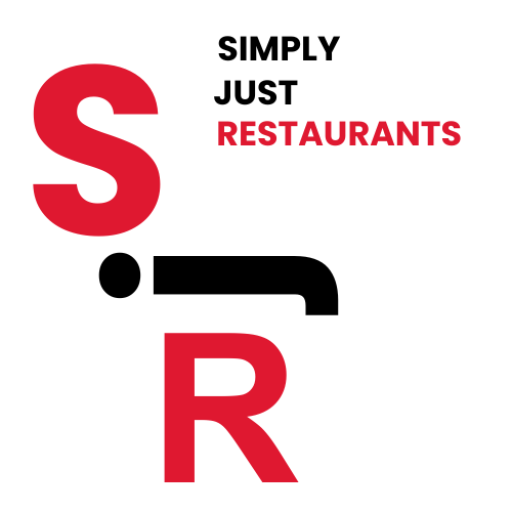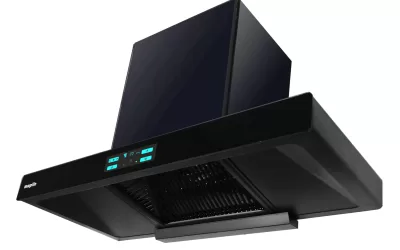- Introduction To The Commercial Kitchen
- 1. Types of Commercial Kitchen Equipment
- 2. Selecting the Right Commercial Kitchen Equipment
- 3. Setting Up Your Commercial Kitchen
- 4. Maintenance and Troubleshooting For Commercial Kitchen Equipment
- 5. Emerging Trends in Commercial Kitchen Equipment
- 10. Conclusion
Introduction To The Commercial Kitchen
Commercial kitchen equipment is designed to meet the demands of high-volume cooking in restaurants, hotels, catering businesses, and other food service establishments. These pieces of equipment are built to be durable, efficient, and capable of handling the rigorous daily tasks of a professional kitchen. Understanding the various types of commercial kitchen equipment, their functions, and how to choose the right ones for your kitchen can significantly impact the efficiency and success of your food service operation.

1. Types of Commercial Kitchen Equipment
Commercial kitchen equipment can be broadly categorized into several types, each serving a specific purpose. Here’s an overview of the main categories:
a. Cooking Equipment
Ranges and Ovens
- Ranges: Commercial ranges come in various configurations, including gas, electric, and induction. They often combine a stovetop with an oven beneath, providing versatile cooking capabilities.
- Ovens: There are several types of ovens, including convection ovens, deck ovens, conveyor ovens, and combination ovens. Each type serves different cooking needs, from baking to roasting and broiling.
Grills and Griddles
- Grills: Charbroilers and flat-top grills are essential for cooking meats and vegetables with a distinct grilled flavor. They come in gas and electric models.
- Griddles: Griddles provide a flat, heated surface for cooking a variety of foods, including pancakes, burgers, and eggs.
Fryers
- Deep Fryers: Used for frying foods such as French fries, chicken, and doughnuts. They come in countertop and floor models, with electric or gas heating options.
- Pressure Fryers: Similar to deep fryers but cook food under pressure, which speeds up cooking time and reduces oil absorption.
Specialty Cooking Equipment
- Steamers: Use steam to cook vegetables, seafood, and other foods quickly while retaining nutrients.
- Tilting Skillets/Braising Pans: Versatile pieces of equipment used for sautéing, frying, simmering, and braising large quantities of food.
b. Refrigeration Equipment
Reach-In Refrigerators and Freezers
- Reach-In Units: Essential for storing perishable items. They come in single, double, and triple-door configurations.
- Undercounter Units: Compact refrigerators and freezers that fit under countertops for easy access.
Walk-In Coolers and Freezers
- Large, room-sized units used for storing bulk quantities of ingredients. They provide ample storage space and help maintain inventory for high-volume operations.
Prep Tables and Salad Bars
- Refrigerated Prep Tables: Combine a work surface with refrigerated storage, ideal for sandwich and pizza preparation.
- Salad Bars: Keep ingredients chilled and accessible for assembling salads and other cold dishes.
c. Food Preparation Equipment
Mixers
- Planetary Mixers: Versatile mixers used for blending, mixing, and kneading dough. They come in various sizes to accommodate different batch sizes.
- Spiral Mixers: Specifically designed for mixing dough, they are commonly used in bakeries and pizzerias.
Food Processors
- Batch Bowl Processors: Suitable for chopping, slicing, and pureeing in small batches.
- Continuous Feed Processors: Ideal for high-volume operations, they allow continuous feeding of ingredients.
Slicers and Dicers
- Meat Slicers: Used for slicing meats and cheeses to precise thicknesses.
- Vegetable Slicers and Dicers: Automate the process of cutting vegetables into uniform pieces.
Blenders
- Immersion Blenders: Handheld blenders used for blending soups, sauces, and other liquids directly in the pot.
- Countertop Blenders: Versatile blenders used for making smoothies, sauces, and purees.
d. Storage and Shelving
Shelving Units
- Wire Shelving: Provides ventilation and is adjustable, making it ideal for dry storage.
- Solid Shelving: Suitable for storing heavy items and preventing spills.
Food Storage Containers
- Cambro Containers: Durable, stackable containers used for storing ingredients and prepared foods.
- Ingredient Bins: Large bins with scoops, used for storing bulk dry ingredients like flour and sugar.
e. Dishwashing Equipment
Dishwashers
- Undercounter Dishwashers: Compact units suitable for smaller kitchens.
- Door-Type Dishwashers: Larger units designed for high-volume dishwashing.
- Conveyor Dishwashers: Used in large operations, these machines automate the process of moving dishes through washing, rinsing, and drying.
Sinks and Faucets
- Three-Compartment Sinks: Used for washing, rinsing, and sanitizing dishes manually.
- Prep Sinks: Smaller sinks used for washing vegetables and other ingredients.
f. Beverage Equipment
Coffee and Espresso Machines
- Drip Coffee Makers: Brew large quantities of coffee quickly.
- Espresso Machines: Used for making espresso and espresso-based drinks.
Juice Extractors and Blenders
- Juice Extractors: Extract juice from fruits and vegetables.
- Bar Blenders: Used for making cocktails and smoothies.
Soda Machines and Dispensers
- Provide carbonated beverages and are commonly used in fast food restaurants and cafeterias.
g. Safety and Sanitation Equipment
Handwashing Stations
- Hand Sinks: Dedicated sinks for handwashing, essential for maintaining hygiene.
- Sanitizer Dispensers: Ensure proper hand sanitation.
Grease Traps
- Prevent grease from entering the plumbing system, which can cause blockages.
Fire Suppression Systems
- Installed in the hood over cooking equipment to extinguish fires automatically.
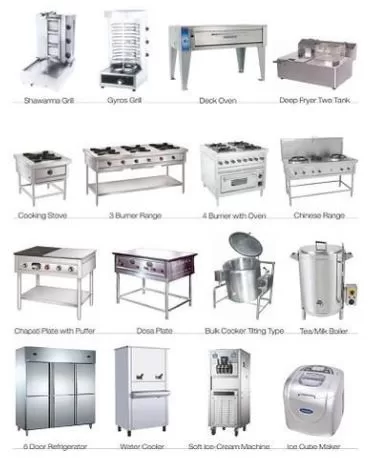
2. Selecting the Right Commercial Kitchen Equipment
Choosing the right equipment for your commercial kitchen involves several considerations. Here are some key factors to keep in mind:
a. Assessing Your Needs
- Menu: Your menu dictates the types of equipment you need. For example, a bakery will need mixers and ovens, while a pizzeria will require pizza ovens and dough mixers.
- Volume: Consider the volume of food you’ll be preparing. High-volume kitchens need robust equipment that can handle continuous use.
- Space: Measure your kitchen space to ensure the equipment fits comfortably and allows for efficient workflow.
b. Budget
- Initial Cost: Determine your budget for purchasing equipment. Remember that investing in high-quality equipment can save money in the long run by reducing maintenance and replacement costs.
- Operating Costs: Consider the energy efficiency of the equipment, as this will impact your utility bills.
c. Brand and Warranty
- Reputable Brands: Choose equipment from reputable brands known for their quality and reliability.
- Warranty: Look for equipment with a comprehensive warranty to protect your investment.
d. Compliance and Safety
- Health Codes: Ensure the equipment meets local health and safety codes.
- Certifications: Look for certifications like NSF (National Sanitation Foundation) for safety and sanitation.
e. Maintenance and Support
- Ease of Cleaning: Choose equipment that is easy to clean and maintain.
- Service and Parts: Ensure that service and replacement parts are readily available.

3. Setting Up Your Commercial Kitchen
Proper setup and organization of your commercial kitchen are crucial for efficiency and safety. Here are some steps to consider:
a. Layout and Design
- Workflow: Design the kitchen layout to facilitate a smooth workflow from preparation to cooking to serving.
- Zones: Create distinct zones for different tasks, such as food prep, cooking, dishwashing, and storage.
b. Installation
- Professional Installation: Hire professionals to install the equipment to ensure it is set up correctly and safely.
- Utility Connections: Ensure proper connections for gas, electricity, and water.
c. Training
- Staff Training: Train your staff on how to use and maintain the equipment properly.
- Safety Procedures: Implement safety procedures to prevent accidents and injuries.
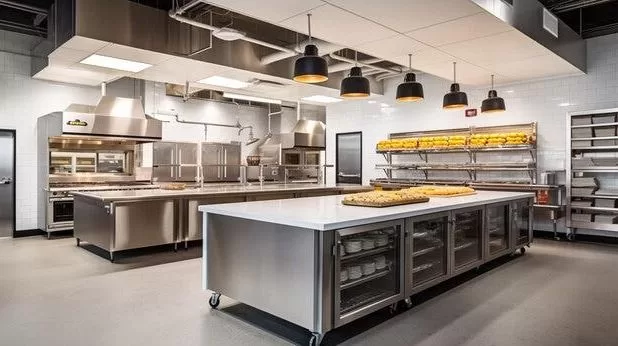
4. Maintenance and Troubleshooting For Commercial Kitchen Equipment
Regular maintenance is essential to keep your equipment running smoothly. Here are some maintenance tips and troubleshooting guidelines:
a. Routine Maintenance
- Cleaning: Clean the equipment regularly to prevent buildup of food particles and grease.
- Inspection: Inspect the equipment for wear and tear and replace parts as needed.
- Lubrication: Lubricate moving parts to ensure smooth operation.
b. Troubleshooting Common Issues
- Temperature Problems: If an oven or fryer isn’t reaching the correct temperature, check the thermostat and heating elements.
- Power Issues: Ensure the equipment is properly plugged in and check the circuit breaker if there’s no power.
- Noise: Unusual noises can indicate a mechanical problem. Inspect moving parts and bearings for wear.
c. Professional Service
- Service Contracts: Consider service contracts with professional technicians for regular maintenance and emergency repairs.
- Manufacturer Support: Contact the manufacturer for support if you encounter persistent issues.
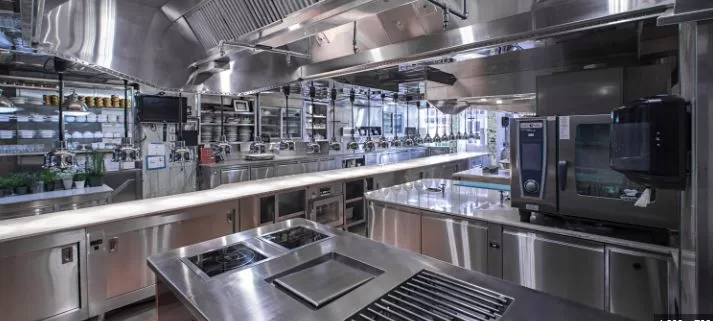
5. Emerging Trends in Commercial Kitchen Equipment
The food service industry is constantly evolving, and new technologies are shaping the future of commercial kitchens. Here are some emerging trends:
a. Smart Kitchen Equipment
- IoT Integration: Smart kitchen equipment can connect to the Internet of Things (IoT), allowing for remote monitoring and control.
- Data Analytics: Equipment with data analytics capabilities can provide insights into usage patterns and help optimize operations.
b. Energy Efficiency
- Energy Star Certification: Look for equipment with Energy Star certification for energy efficiency.
- Sustainable Practices: Adopt sustainable practices, such as using energy-efficient equipment and reducing waste.
c. Multi-Function Equipment
- Combination Ovens: Ovens that combine steaming, baking, and roasting functions in one unit.
- All-in-One Workstations: Workstations that integrate multiple prep and cooking functions to save space and improve efficiency.
d. Customization and Modularity
- Customizable Equipment: Equipment that can be customized to fit specific needs and preferences.
- Modular Design: Modular equipment allows for flexibility and easy reconfiguration as needs change.
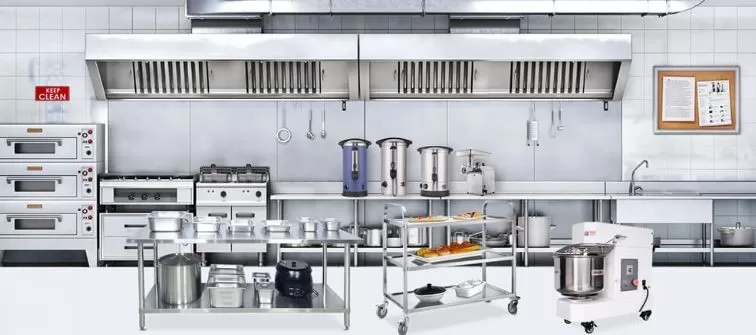
10. Conclusion
Commercial kitchen equipment plays a vital role in the success of any food service operation. From cooking and refrigeration to food preparation and sanitation, each piece of equipment serves a specific function that contributes to the overall efficiency and productivity of the kitchen.
By understanding the different types of equipment, assessing your needs, and making informed purchasing decisions, you can equip your kitchen with the tools necessary to deliver high-quality food and service.
Regular maintenance and staying informed about emerging trends will ensure your kitchen remains up-to-date and operates smoothly. Investing in the right commercial kitchen equipment is an investment in the future success of your food service business.
About Author sudeshna mukherjee
You May Also Like…
2024 Buyer’s Guide: How to Choose the Best Auto Clean Chimney for Your Kitchen
IntroductionA chimney is essential for a clean and safe kitchen. Kitchen chimneys are essential for aesthetics and...
How to Choose the Right POS Software for Your Restaurant in India
Introduction Profits are what make it all worthwhile. Running a successful restaurant requires an efficient...

